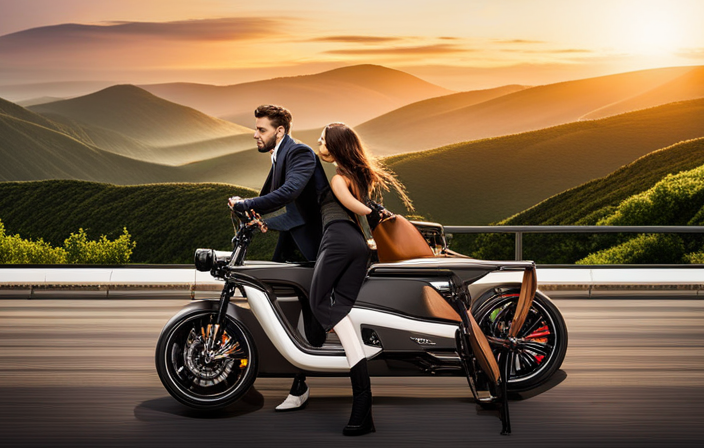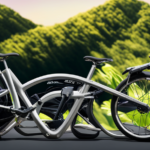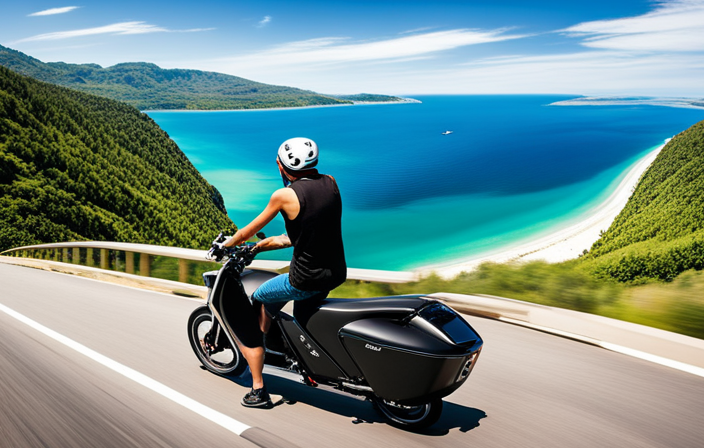As the saying goes, ‘Time flies when you’re having fun.’ But when it comes to electric bike batteries, the question arises: how long do they really last?
In this article, I will delve into the technical aspects of electric bike batteries, exploring their average lifespan, factors that can impact their longevity, and tips to maximize their performance.
Get ready to ride with confidence as we uncover the truth behind the endurance of electric bike batteries.
Key Takeaways
- Electric bike batteries have a limited lifespan.
- Factors affecting battery lifespan include riding style, maintenance, temperature, storage conditions, and charging habits.
- Lead-acid batteries last around 300-500 charge cycles.
- Regularly checking the battery’s charge level and following proper charging and storage practices can extend battery lifespan.
Understanding Electric Bike Batteries
Electric bike batteries, like their traditional counterparts, have a limited lifespan but can power your adventures for several years. Understanding electric bike batteries is crucial for maximizing their performance.
The average battery capacity of an electric bike is typically measured in watt-hours (Wh), which represents the amount of energy the battery can store. Common battery issues include reduced capacity over time, decreased performance in extreme temperatures, and the possibility of damage from overcharging or deep discharging.
It’s important to regularly check the battery’s charge level and avoid leaving it completely discharged for extended periods.
Now that we’ve covered the basics of electric bike batteries, let’s delve into the average lifespan of these power sources without compromising the longevity of your adventures.
Average Lifespan of Electric Bike Batteries
The discussion on the average lifespan of electric bike batteries will focus on three key points: factors affecting battery lifespan, the typical lifespan of different battery types, and strategies to extend battery life.
Understanding these factors is crucial for users to make informed decisions about their electric bike batteries.
By analyzing these aspects, we can gain a technical understanding of how to optimize the performance and longevity of our electric bike batteries.
Factors Affecting Battery Lifespan
One of the key factors that affects how long your electric bike battery will last is the way you ride it. Your riding style, including how often and how hard you accelerate and brake, can have a significant impact on battery performance.
Additionally, maintaining your battery properly is crucial for maximizing its lifespan. Factors such as temperature, storage conditions, and charging habits can all affect battery performance. Common battery maintenance mistakes, such as overcharging or letting the battery fully discharge, can also shorten its lifespan.
It is important to be aware of these factors and take proper care of your electric bike battery to ensure it lasts as long as possible.
Moving on to the next section about the typical lifespan of different battery types…
Typical Lifespan of Different Battery Types
To get the most mileage out of your electric bike battery, it’s important to choose wisely as different battery types have their own unique lifespans. Here are the typical lifespans of different electric bike battery types:
-
Lead-acid batteries: These are the most affordable option but have the shortest lifespan, typically lasting around 300-500 charge cycles.
-
Nickel-metal hydride (NiMH) batteries: These offer a slightly longer lifespan of about 500-1000 charge cycles.
-
Lithium-ion (Li-ion) batteries: These are the most common type and can last anywhere from 500-1000 charge cycles, depending on their quality and battery management system.
-
Lithium polymer (LiPo) batteries: These are the newest and most advanced type, with a lifespan of 800-1000 charge cycles.
To ensure a longer battery lifespan, regular battery maintenance and careful management of battery capacity are crucial. Now, let’s explore how to extend battery life without compromising performance.
How to Extend Battery Life
Maximize the lifespan of your electric bike battery by implementing these simple tips and tricks. Proper battery maintenance and charging habits are crucial for extending the life of your electric bike battery.
Firstly, it is important to store your battery in a cool and dry place, away from extreme temperatures and moisture. Regularly clean the battery terminals to prevent corrosion, which can affect the battery’s performance.
When charging your battery, avoid overcharging by unplugging it once it is fully charged. It is also recommended to charge your battery at regular intervals, even if you haven’t used your bike, to prevent the battery from fully discharging.
By following these guidelines, you can significantly increase the lifespan of your electric bike battery.
Transitioning into the subsequent section about factors that can affect battery longevity, it is important to consider external factors that may impact the overall lifespan of your battery.
Factors That Can Affect Battery Longevity
Are there any factors that can affect how long an electric bike battery lasts? Absolutely.
Several factors can impact the longevity of an electric bike battery. Understanding these factors and implementing strategies to optimize battery lifespan is crucial for maximizing performance.
Here are three key factors affecting battery performance:
-
Temperature: Extreme temperatures, both hot and cold, can significantly decrease battery life. It’s essential to store and charge the battery in moderate temperature conditions.
-
Terrain: Riding on hilly terrains or rough surfaces requires more power from the battery, reducing its lifespan. Choosing flatter routes whenever possible can help extend battery life.
-
Maintenance: Regular maintenance, such as keeping the battery clean and properly aligned, can greatly impact battery performance and longevity.
By considering these factors, you can ensure that your electric bike battery lasts longer.
Now, let’s move on to the next section about tips to maximize battery performance.
Tips to Maximize Battery Performance
Get the most out of your electric bike’s battery by following these simple tips. Maximizing battery efficiency and preserving battery health are key to ensuring your electric bike’s battery lasts as long as possible. Here are some tips to help you achieve this:
-
Charge Properly: Always use the charger provided by the manufacturer and follow their instructions for charging. Avoid overcharging or leaving the battery completely drained for extended periods.
-
Store Correctly: When not in use, store your electric bike in a cool, dry place. Extreme temperatures can negatively impact battery performance.
-
Avoid Excessive Stress: Try to ride your electric bike on flat terrain or use lower assist levels when going uphill. This can help reduce the strain on the battery.
By implementing these tips, you can maximize your battery’s performance and extend its lifespan. In the next section, we will discuss signs of battery deterioration.
Signs of Battery Deterioration
To maximize the performance of your electric bike battery, I provided some helpful tips in the previous subtopic. However, it is crucial to be aware of signs that indicate battery deterioration.
Regular battery maintenance is essential to ensure its longevity and efficiency. Signs of battery wear may include decreased range per charge, increased charging time, reduced power output, and a noticeable decrease in overall battery performance. Additionally, if you notice any physical damage to the battery, such as swelling or leakage, it is a clear indication of deterioration.
Proper care and attention to these signs will help you identify when it is time to consider battery replacement options. Speaking of which, let’s move on to the next section to explore various choices for battery replacement.
Battery Replacement Options
Consider exploring different options for replacing your battery to ensure that your electric bike continues to deliver the power and performance you need.
When it comes to battery replacement, there are two main options to consider: battery upgrade and DIY battery repairs.
If you’re looking to improve the overall performance and range of your electric bike, a battery upgrade might be the best choice. Upgrading to a higher capacity battery can provide you with longer ride times and increased power output.
On the other hand, if you’re comfortable with DIY repairs, you can explore options for replacing individual battery cells or components to extend the lifespan of your current battery. However, it’s important to note that DIY repairs require technical knowledge and can void warranties.
Transitioning to the next section about battery recycling and disposal, it’s essential to consider the environmental impact of disposing of your old battery responsibly.
Battery Recycling and Disposal
When it comes to the end of a battery’s life, it is crucial to handle its disposal properly. Battery disposal is a critical aspect of sustainable electric transportation.
Improper disposal can lead to significant environmental impact due to the potential release of harmful chemicals and heavy metals. Recycling is the most responsible way to dispose of electric bike batteries. Recycling facilities can safely extract valuable materials from the batteries and reduce the need for new raw materials.
Additionally, recycling helps prevent these hazardous materials from ending up in landfills or being incinerated, which can harm the environment. As a result, recycling electric bike batteries not only protects the environment but also conserves valuable resources.
Now that we understand the importance of battery recycling and disposal, let’s move on to comparing electric bike batteries.
Comparing Electric Bike Batteries
While some electric bike batteries may be as powerful as a race car engine, others may have the capacity of a small flashlight. When comparing electric bike battery capacity, it is crucial to consider the specific needs of the rider.
Two key factors to assess are the battery’s voltage and ampere-hour (Ah) rating. The voltage determines the power output, while the Ah rating indicates the battery’s capacity to store energy. Higher voltage batteries generally offer greater torque and acceleration, but they also consume more energy. On the other hand, a higher Ah rating provides a longer range but may sacrifice some power.
When evaluating battery performance, it is essential to strike a balance between power and range that aligns with personal preferences and usage patterns. Understanding warranty coverage is another critical aspect of owning an electric bike, ensuring peace of mind and protection against potential issues.
Understanding Warranty Coverage
When it comes to understanding warranty coverage for electric bike batteries, there are three key points to consider.
First, it’s important to carefully review the manufacturer’s warranty details to understand what is covered and for how long.
Second, it may be beneficial to explore extended warranty options to provide additional protection beyond the standard coverage.
Lastly, it’s crucial to read the fine print of any warranty agreement to ensure that there are no hidden clauses or exclusions that may impact the coverage.
Manufacturer Warranty Details
You can check the manufacturer warranty details to find out how long an electric bike battery typically lasts. The manufacturer warranty will outline the specific duration of coverage for the battery, which can vary depending on the brand and model of the electric bike.
Understanding battery performance and battery charging techniques is crucial to maximizing the lifespan of your battery. Battery lifespan can be influenced by various factors, such as usage patterns, charging habits, and environmental conditions. By following recommended charging practices and taking proper care of the battery, you can help extend its lifespan.
However, if you are looking for additional protection beyond the manufacturer warranty, you may want to consider exploring extended warranty options. These options can provide you with added peace of mind and coverage for a longer period of time.
Extended Warranty Options
If you’re lucky, maybe the warranty for your electric bike battery will expire right when you need it the most. However, if that’s not the case, there are extended warranty options available for you to consider.
These options often provide additional coverage for your battery beyond the manufacturer’s warranty period. When looking into extended warranties, it’s important to consider the battery replacement options that are included.
Some warranties may offer a replacement battery free of charge, while others may require you to pay a certain percentage of the battery’s cost. Additionally, it’s crucial to think about battery recycling and disposal when your battery reaches the end of its life.
Many extended warranty plans include provisions for proper battery recycling, ensuring that your old battery is disposed of safely and responsibly. Understanding these aspects is crucial, so let’s delve into the importance of reading the fine print in the next section.
Importance of Reading the Fine Print
Before making any decisions, make sure to carefully read the fine print to fully understand the terms and conditions of the extended warranty. This step is crucial to avoid any surprises or hidden costs down the road.
When it comes to electric bike batteries, understanding the fine print is particularly important. The fine print often includes details about battery maintenance requirements and any limitations on coverage. By understanding these terms, you can plan for the future and ensure that your battery lasts as long as possible.
It is important to note that while an extended warranty can provide peace of mind, it does not guarantee that your battery will last indefinitely. Factors such as usage, charging habits, and environmental conditions can also impact battery lifespan.
Therefore, it is important to consider other factors when thinking about the future of electric bike batteries, which will be discussed in the next section.
The Future of Electric Bike Batteries
The future of electric bike batteries is bright, with advancements in technology promising longer-lasting and more efficient power sources. Rechargeable battery advancements have paved the way for batteries that can provide extended range and increased power for electric bikes.
Future battery charging methods are being developed to further enhance the user experience. Here are three exciting developments to look forward to:
-
Rapid Charging: Imagine being able to charge your electric bike battery in a matter of minutes, just like you would charge your smartphone. This breakthrough in charging technology will greatly reduce downtime and increase convenience.
-
Wireless Charging: Say goodbye to messy cables and connectors. Wireless charging technology will allow you to simply place your electric bike on a charging pad, eliminating the need for physical connections.
-
Solar Charging: Harnessing the power of the sun, solar charging technology will enable electric bike batteries to be charged through solar panels integrated into the bike frame. This eco-friendly solution will provide an endless source of energy.
As we explore the future of electric bike batteries, it’s important to address frequently asked questions about their lifespan and maintenance.
Frequently Asked Questions about Electric Bike Batteries
Get ready to have all your burning questions about electric bike batteries answered! In this section, we will delve into battery charging techniques and troubleshooting common battery issues. To help you better understand these concepts, let’s take a look at a table that summarizes some key information:
| Battery Charging Techniques | Troubleshooting Common Battery Issues |
|---|---|
| Use the manufacturer’s recommended charger | Battery not holding a charge |
| Charge the battery at room temperature | Sudden drop in battery capacity |
| Avoid overcharging the battery | Inconsistent power output |
| Charge the battery fully before long periods of inactivity | Battery not connecting properly |
| Regularly check for loose connections | Battery not charging |
By following these techniques and troubleshooting any issues that arise, you can ensure optimal performance and longevity of your electric bike battery. Now, let’s move on to the next section where we will provide expert tips for battery maintenance and care.
Expert Tips for Battery Maintenance and Care
To ensure your battery stays in top shape, here’s a nugget of wisdom: give it some TLC!
Proper battery storage is crucial for maintaining its longevity. Firstly, always store your electric bike battery in a cool and dry place. Extreme temperatures can have a negative impact on its performance.
Secondly, avoid keeping the battery fully charged or fully discharged for extended periods. This can lead to capacity loss over time. It’s recommended to store the battery at around 50% charge.
Lastly, be mindful of common battery problems such as overcharging, undercharging, and excessive heat generation during charging. Regularly inspect the battery for any signs of damage or corrosion.
By following these maintenance tips, you can extend the lifespan of your electric bike battery.
Now, let’s delve into real-life stories and experiences with electric bike batteries.
Real-Life Stories and Experiences with Electric Bike Batteries
Imagine cruising along a scenic coastal path, feeling the wind in your hair and effortlessly gliding up hills, all thanks to the power of your trusty e-bike’s battery. Electric bike battery care is crucial to ensure a long-lasting and reliable performance. Common battery issues can include decreased range, reduced power output, and even complete failure. To help you understand the importance of proper maintenance, let’s take a look at some real-life stories and experiences with electric bike batteries:
| Story | Battery Issue | Solution |
|---|---|---|
| John | Decreased range | Replaced old battery with a new one |
| Lisa | Reduced power output | Cleaned battery terminals and contacts |
| Mike | Complete failure | Regularly charged battery to prevent deep discharge |
These stories highlight the significance of regular care and maintenance for your electric bike battery. Proper care can extend the lifespan of your battery and prevent common issues. Now, let’s delve into the best practices for charging your electric bike battery.
Best Practices for Charging Your Electric Bike Battery
Ensure that you follow these best practices when charging your e-bike battery to maximize its performance and keep it running smoothly.
-
Use the charger provided by the manufacturer: Using a charger from a different brand may not provide the correct voltage or current, which can damage the battery.
-
Charge your battery at room temperature: Extreme temperatures can affect the battery’s performance and lifespan. Avoid charging in extremely hot or cold environments.
-
Avoid overcharging: Once your battery reaches 100% charge, unplug it from the charger. Overcharging can shorten the battery’s lifespan.
By following these charging techniques and practicing good battery maintenance, you can prolong the lifespan of your electric bike battery and ensure that it performs optimally. It’s important to take these steps to maximize your battery’s longevity and get the most out of your electric bike.
In the next section, we’ll discuss final thoughts on electric bike battery lifespan.
Final Thoughts on Electric Bike Battery Lifespan
Now that we have discussed the best practices for charging your electric bike battery, let’s delve into some final thoughts on its lifespan.
It is crucial to understand that the longevity of an electric bike battery greatly depends on various factors, including battery charging techniques and the impact of weather conditions.
When it comes to battery charging techniques, it is essential to follow the manufacturer’s guidelines and use a compatible charger. Overcharging or undercharging can negatively affect the battery’s lifespan. Additionally, avoiding extreme temperatures during charging can help maintain optimal battery health.
Furthermore, weather conditions play a significant role in determining the battery’s lifespan. Extreme temperatures, whether hot or cold, can cause the battery to degrade more quickly. It is important to store and charge your electric bike battery in a moderate temperature environment to maximize its longevity.
By implementing proper battery charging techniques and being mindful of weather conditions, you can ensure that your electric bike battery lasts as long as possible, providing you with an excellent riding experience for years to come.
Frequently Asked Questions
Can I use a different brand of battery for my electric bike?
Using a different brand of battery for an electric bike is like fitting a square peg into a round hole. While it may work, there are pros and cons to consider, such as compatibility, performance, and warranty coverage.
How often should I charge my electric bike battery?
To maximize the lifespan of an electric bike battery, it is important to charge it regularly. Factors such as temperature, battery capacity, and usage patterns can affect the charging time.
Can I leave my electric bike battery charging overnight?
Leaving an electric bike battery charging overnight can pose potential risks, such as overcharging and overheating, which may shorten its lifespan. Proper maintenance, including regular charging and storage at optimal temperatures, is crucial for maximizing battery longevity.
Is it possible to upgrade the battery capacity of my electric bike?
Yes, it is possible to upgrade the battery capacity of my electric bike. By doing so, I can improve battery performance and extend battery life, allowing for longer rides and more efficient use of the bike.
What should I do if my electric bike battery stops holding a charge?
If my electric bike battery stops holding a charge, I would troubleshoot common issues such as checking the connections, ensuring proper charging, and avoiding extreme temperatures. To prolong the battery’s lifespan, I would follow recommended charging practices and store it in a cool, dry place.
Conclusion
Well, folks, there you have it – the ultimate guide to electric bike batteries!
After diving deep into the world of battery longevity and maintenance, it’s clear that these powerhouses can truly go the distance.
With the right care and attention, your electric bike battery will stick by your side for ages, providing you with countless exhilarating adventures.
So, fear not, fellow riders, for your battery will not let you down.
Embrace the power, embrace the ride, and let your electric bike battery take you to new heights!
















